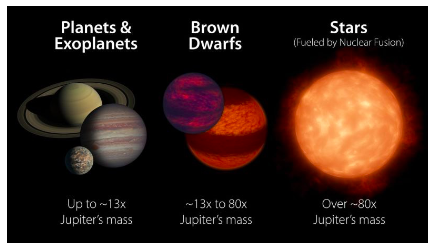Quarks to Cosmos midterm
1/51
There's no tags or description
Looks like no tags are added yet.
Name | Mastery | Learn | Test | Matching | Spaced |
|---|
No study sessions yet.
52 Terms
What is Kelper’s first law?
Planets move around the sun in ellipses, with the sun at one focus.
The Sun's center is always located at one focus of the orbital ellipse. The Sun is at one focus. The planet follows the ellipse in its orbit, meaning that the planet to Sun distance is constantly changing as the planet goes around its orbit.
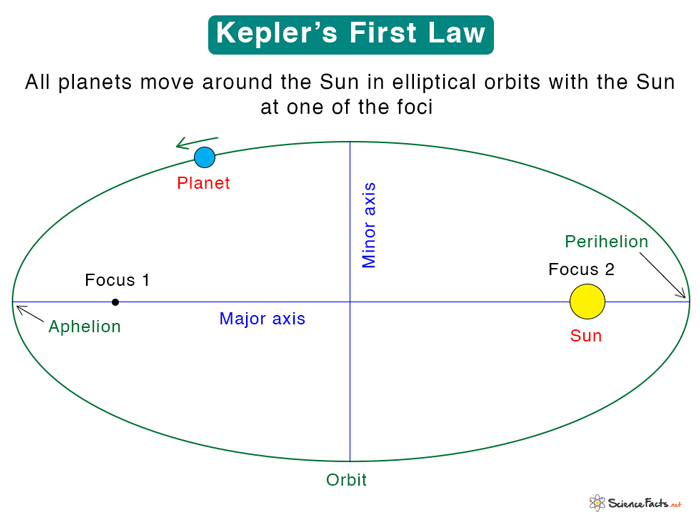
What is Kelper’s second law?
The area swept out by a planet in any time interval is always the same.
The imaginary line joining a planet and the Sun sweeps equal areas of space during equal time intervals as the planet orbits. Basically, that planets do not move with constant speed along their orbits. Rather, their speed varies so that the line joining the centers of the Sun and the planet sweeps out equal parts of an area in equal times.
The point of nearest approach of the planet to the Sun is termed perihelion. The point of greatest separation is aphelion, hence by Kepler's Second Law, a planet is moving fastest when it is at perihelion and slowest at aphelion.

What is Kelper’s third law?
The period P of the planet is related to its semimajor axis a (the average distance between the planet and the Sun) roughly the same as the radius in our solar system by:
P² = a³
It implies that the period for a planet to orbit the Sun increases rapidly with the radius of its orbit. (Father away a planet is from the sun, longer it takes to complete an orbit).
Applying K3 to jupiter:
P = orbital period of time of a planet (years)
a = semi major axis of (AU) the orbit
P = 11.86 years , P² = 140.66
a = 5.6 AU , a³ = 140.6
How does Newton’s Law of universal gravity give us Kepler’s 3rd law? (why planets move slower the farther away they get from the sun)
Though Kepler hadn't known about gravitation when he came up with his three laws, they were instrumental in Newton deriving his theory of universal gravitation, which explains the unknown force behind Kepler's Third Law.
Planets move slower when they are farther away from the sun because the gravitational pull gets from the sun is weaker the further out the planet is. Thus, causing it’s orbit to slow.
What is Newton’s first law?
Law of inertial bodies:
Bodies in motion tend to stay in motion, bodies at rest tend to stay at rest.
A different way to state this, is that if a body’s instantaneous velocity is constant, then the sum of the forces acting on the body are zero.
How is “uniform motion” a different way of expressing Newton’s first law?
“Uniform motion is natural. It requires no explanation. What requires explanation is a change in motion.”
"Uniform motion" is another way of saying that an object is moving at a constant velocity; therefore, describing an object as being in "uniform motion" is a way of expressing the core concept of Newton's first law, which is the idea of an object maintaining its state of motion (either at rest or constant velocity) without any external forces acting on it.
What is Newton’s second law?
The rate of change of momentum of a body is proportional to the total force acting on the body.
momentum is mass times velocity (you might say momentum is “how much inertia a body has”).
Mathematically expressed as:
F = m*a
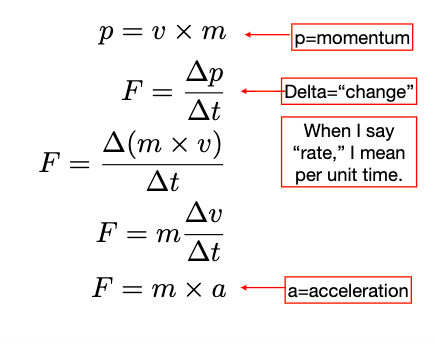
How does the formula to Newton's second law indicate that force is required to change a body’s momentum?
Newton's second law, F = ma (force equals mass times acceleration), means that you need a force to change how fast something is moving. The law shows that force is linked to how quickly the speed changes. If you want to change an object's momentum (which is its mass times velocity), you need a non-zero force to make it happen.
What is Newton’s third law?
When one body exerts a force on a second body, the second body simultaneously exerts a force equal in magnitude and opposite in direction on the first body.
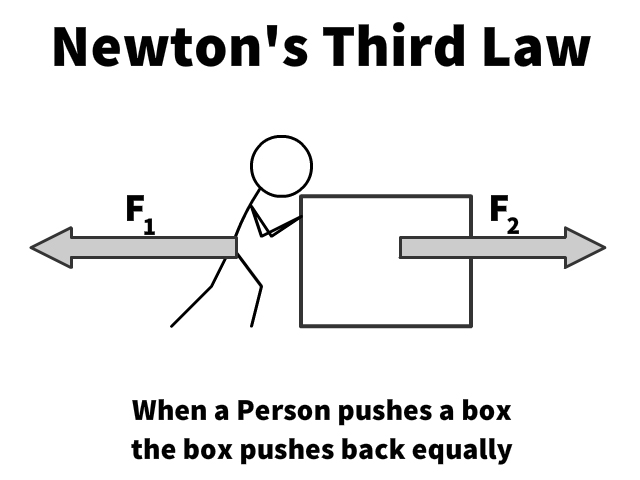
What is the Universal Law of Gravity?
Every mass in the universe attracts every other mass with a force, which is directly proportional to the product of the two masses, and is inversely proportional to the square of the distances between them.
F: gravitational force between two objects
G: gravitational constant 6.674 × 10^-11 N (m/kg)²
m1 and m2: masses of the two objects. m1 is the larger mass, m2 is the smaller mass
r: distance between the centers of the two masses (separation b/w masses)
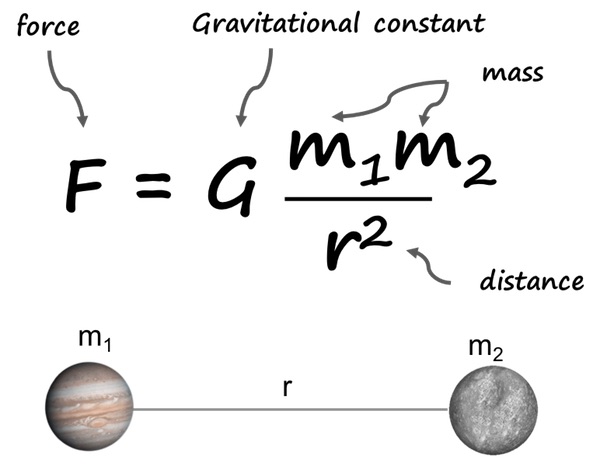
What is a wave?
A disturbance that travels through a medium, transporting energy (not mass).
What is sound?
sound is also a wave
the medium of sound is the air
the air vibrates, and this vibration moves into our ears.
What is constructive interference?
Constructive interference occurs when two or more waves overlap and combine to produce a wave with a greater amplitude than any of the individual waves. This happens when the peaks (or troughs) of the waves align, reinforcing each other and resulting in an increase in intensity.
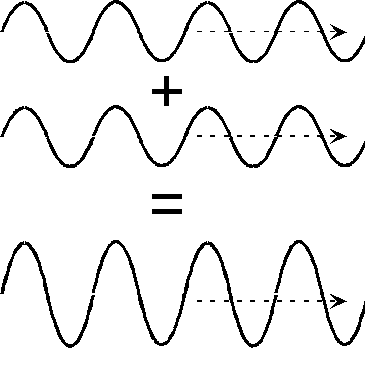
What is deconstructive interference?
Deconstructive interference occurs when two or more waves overlap and combine to produce a wave with a smaller amplitude than any of the individual waves. This happens when the peak of one wave aligns with the trough of another, effectively canceling each other out and reducing the overall intensity.
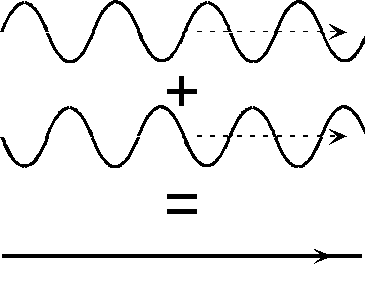
What is the Doppler Effect?
The change in the frequency or wavelength of a wave (like sound or light) as the source and observer move closer together or farther apart. When they move closer, the waves are compressed, causing a higher frequency (bluer light or higher-pitched sound), and when they move apart, the waves are stretched, causing a lower frequency (redder light or lower-pitched sound).
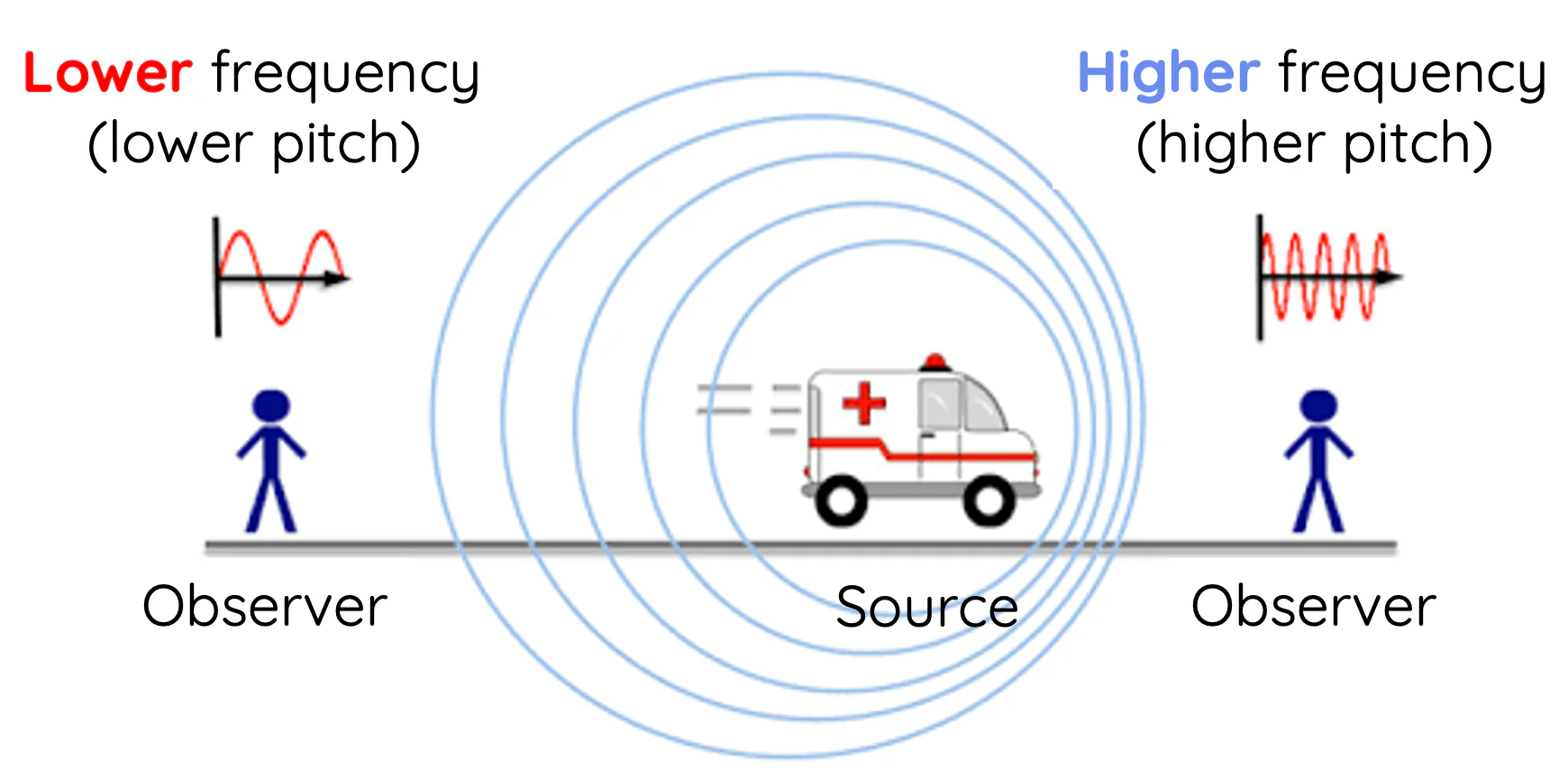
What is Doppler Shift equation?
fobs: observed frequency
femit: emitted frequency
Cs: speed of sound (330 m/s)
delta v: velocity b/w observer and emitter. sign matters! positive - towards, negative - away.
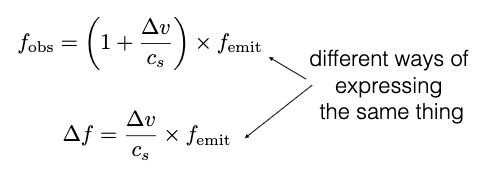
How can light behave like a wave?
Light behaves like a wave because it can spread out, bend, and interfere with itself, similar to water or sound waves. This wave-like behavior is observed in phenomena like redshift and blueshift, where light waves stretch (redshift) when moving away from an observer, causing the light to appear more red, or compress (blueshift) when moving toward an observer, making the light appear more blue. These shifts are a direct result of the Doppler effect applied to light waves.
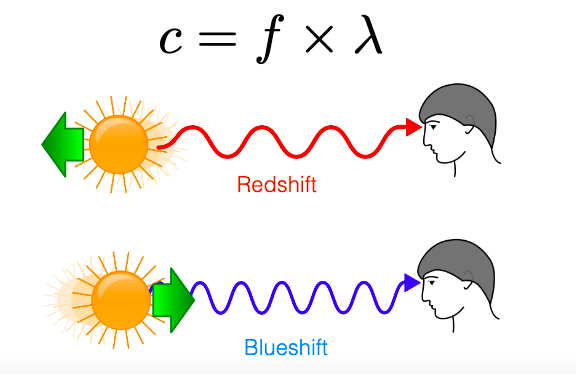
How are light and energy related?
Light is a form of energy. Visible light is a form of radiation, which can be defined as an energy that travels in the form of electromagnetic waves.
The higher the frequency of light (like blue or UV light), the more energy it carries; lower-frequency light (like red or infrared light) carries less energy. In simple terms, light can be thought of as little "packets" of energy, and the more energetic the light, the stronger those packets are.
How do you convert the wavelength of light to energy?
equation:
E = h⋅c / λ
E: the energy of the light
h: Planck's constant (6.626 × 10^−34 J\cdotps)
c: speed of light (3.0 × 10^8 m/s)
λ: wavelength of the light in meters
What is the first thing to know about blackbodies?
Blackbodies emit light at all wavelengths. It may not be very much light when you get to really high or really low energies, but there is a non-zero probability of light from 0 to infinity.
It is an idealized object that absorbs all radiation (light, heat, etc.) that falls on it, without reflecting any.
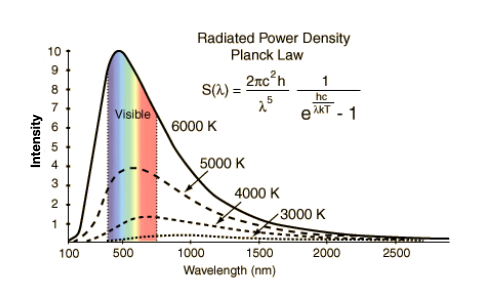
What is the second thing to know about blackbodies?
The shape of the spectrum depends on the temperature. The “peak” moves up to the left as the temperature goes up. The radiation emitted by a blackbody depends only on its temperature.(Here, left means smaller wavelength, so higher photons).
Wein’s Law!

What is the third thing to know about blackbodies?
When the temperature goes up, the light emitted at ALL wavelengths goes up. (more light at ALL wavelengths)
Stefan’s law! (states that the total energy radiated by a blackbody increases with the fourth power of its temperature)
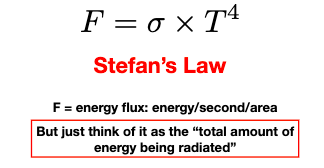
What is a spectrum?
How much light comes out at each wavelength. The “distribution” of energy.
The set of colors into which a beam of light can be separated, or a range of waves, such as light waves or radio waves.
What is a blackbody spectrum?
A “blackbody” is an object that absorbs all light that hits it. (there is no reflection of light.)
The energy absorbed is reemitted. The distribution of the energy (the distribution of the wavelengths of light) is in thermal equilibrium.
Thermal equilibrium means that some amount of light comes out at all wavelengths...
but where that distribution peaks depends on the temperature of the blackbody.
What is an absorption line spectrum?
When starlight passes through a cloud of gas, some of the light is absorbed and some is transmitted through the gas. The wavelengths of light that are absorbed depends on what elements and compounds it is made of.
The exact wavelengths of the lines depends on the properties of the atoms in the gas. Different atoms will create lines in different wavelengths.
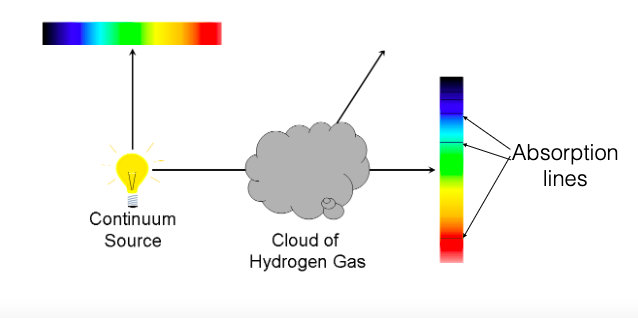
What is an emission line spectrum?
It is a “barcode” of light. When a gas is heated or energized, its atoms or molecules emit light at specific colors (or wavelengths). These colors show up as bright lines on a dark background. An emission line will appear in a spectrum if the source emits specific wavelengths of radiation.
Each element (like hydrogen or helium) produces its own unique set of lines. By studying these lines, can figure out what elements are present in stars or other distant objects.
Since every atom, element and molecule has a unique set of energy levels, the emitted photon (‘packet’ of radiation) has a discrete wavelength, and an energy equal to the difference between the initial and final energy levels.
Emission lines: The same wavelengths as the absorption lines
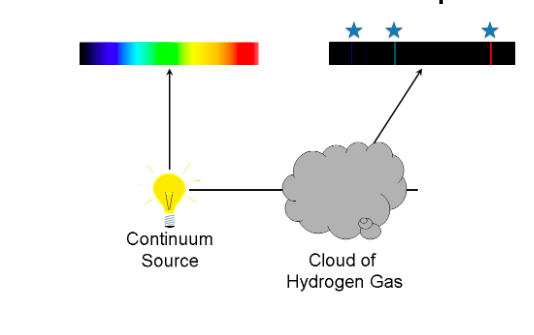
What is the difference between absorption lines and emission lines?
The same cloud of gas produces both emission and absorption spectra.
It all depends on which direction you’re looking at the cloud.
Toward the continuum source, through the cloud, is absorption.
Off to the side, not at the source, you see emission.
Emission spectrum: Bright lines where light is given off.
Absorption spectrum: Dark lines where light is taken away. Do not see the star, only the gas cloud.
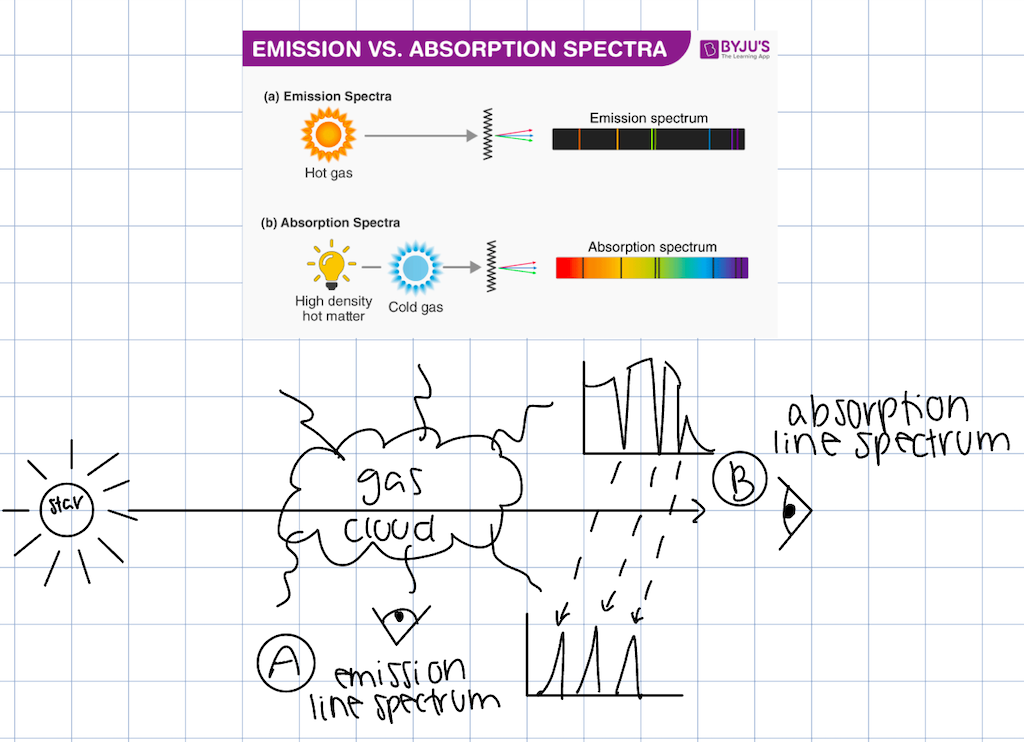
Where do the spectral lines come from?
Atom has nucleus (protons+neutrons, where all the mass is)
Atom has electrons (usually as many as protons=charge neutral).
But elections can only be certain distances from the nucleus.
The distance between the orbital lines is proportional to the energy it takes to jump from one orbit to another.
Moving to higher N requires INPUT of energy.
Moving from higher N to lower N requires RELEASE of energy.
The orbits get closer together the farther from the nucleus you get.
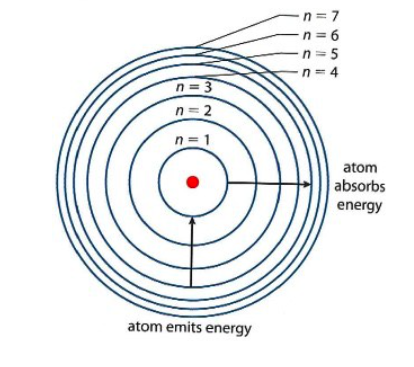
Why can electrons only be at specific locations in the atom?
Electrons can only be in specific locations (energy levels) because they act like waves, and those waves need to "fit" around the nucleus in stable patterns. Only certain patterns are allowed, so the energy levels are fixed and discrete. If the electron tries to be between these levels, it’s unstable and can't stay there. This is a basic rule of quantum mechanics.
It can only orbit where the circumference is equal to an integer number of wavelengths (N).
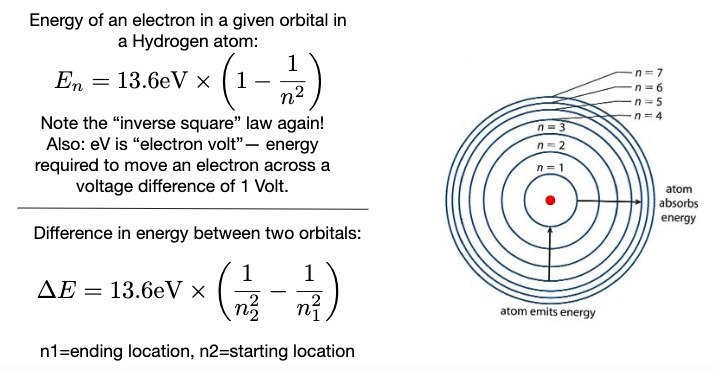
Why do spectral lines appear as lines?
The lines are so precise because the energy levels in atoms are fixed and discrete (they aren't continuous). This means that when electrons transition between levels, the energy (and wavelength) of the absorbed or emitted light is always the same, leading to sharp, distinct lines in the spectrum. If the energy levels were not discrete, you'd see a smeared-out spectrum instead of sharp lines.
What is atomic physics that gives us the wavelengths (energies) of spectral lines?
The wavelengths (or colors) of light emitted or absorbed correspond to the energy difference between two electron levels.
The energy difference, ΔE, between two levels is related to the wavelength (λ) of light by the equation: E = hc/ λE where:
E: energy of the photon,
h: Planck’s constant (6.626 × 10^−34)
c: speed of light (3.0 × 10^8 m/s)
λ: is the wavelength of the light.
When an electron drops from one level to another, it emits light with energy corresponding to this equation. The specific energy levels (and therefore the lines) depend on the type of atom, since each element has its own unique arrangement of energy levels.
What is wave particle duality of matter?
all matter, including particles like electrons, can exhibit both wave-like and particle-like properties depending on the experimental conditions. meaning, they can behave as both a wave and a particle simultaneously depending on how they are observed. Electrons can only be specific distances from the nucleus.
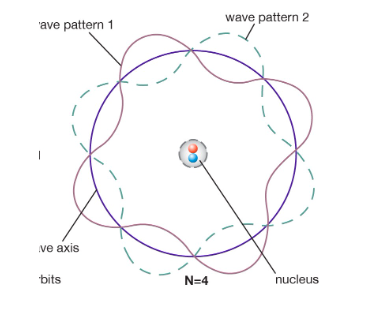
How does wave-particle duality of matter give us fusion in the sun?
In the sun, fusion happens when small nuclei, like hydrogen, combine to form helium, releasing energy. Normally, protons repel each other, but because of wave-particle duality, protons act like waves and use quantum tunneling to "sneak" through the repulsion barrier. Instead of needing enough energy to directly overcome the repulsion, some protons can "tunnel" through the barrier, getting close enough to fuse (a small fraction of them, because it’s a spectrum, and these protons can exist in different places). This allows them to get close enough to fuse, even without having enough energy to collide directly.
Happens to all stars!
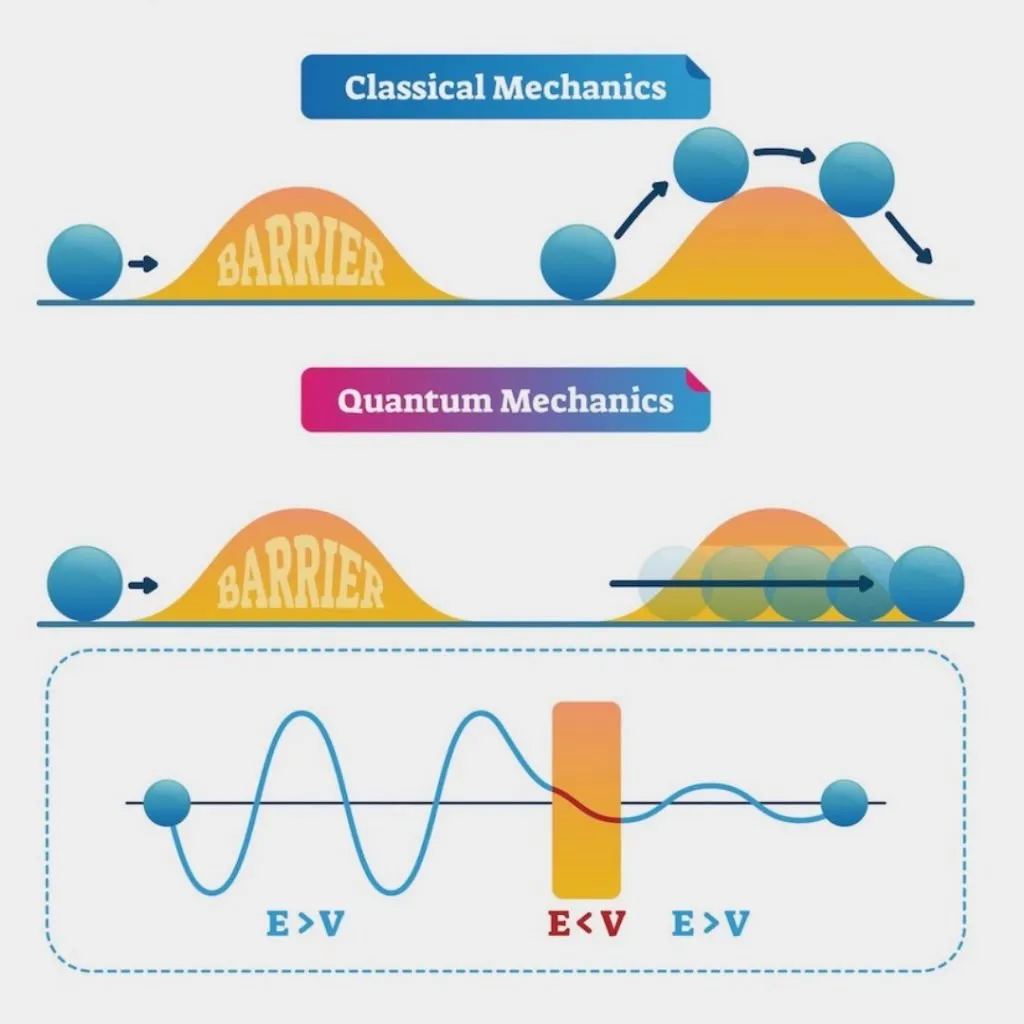
Where and by what process is energy generated in the sun?
the sun’s energy is generated in the core, called nuclear fusion.
with the core’s extreme high temperature/pressure, hydrogen nuclei (protons) move fast enough to overcome their repulsion and fuse together.
The main fusion process is the proton-proton chain, where four hydrogen nuclei (protons) combine through a series of steps to form one helium nucleus.
In this fusion process, some of the mass is converted into energy, according to Einstein’s famous equation, E=mc². This energy is released in the form of light and heat.
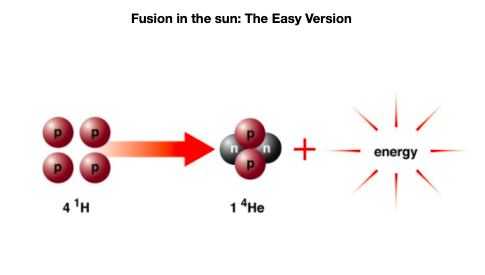
How is heat transported out from the core to the surface? (radiation vs convection)
Radiation zone: energy is transported by photons.
energy moves outward as photons (particles of light) are absorbed and re-emitted by atoms in the dense plasma.
this process is slow, and it can take thousands or even millions of years for a photon to travel through the radiative zone due to constant absorption and re-emission.
Convection zone: energy transported by hot gas bubbles physically moving (like boiling).
In the outer layer, the Sun becomes cooler and less dense, and energy is transported by convection.
Hot plasma rises toward the surface, cools down, and then sinks back down to be reheated, creating convection currents (like boiling water in a pot).
This convective motion helps carry heat to the Sun’s surface more efficiently than radiation in this layer.
Both processes together transport heat from the Sun’s core to its surface, where it is emitted as sunlight.
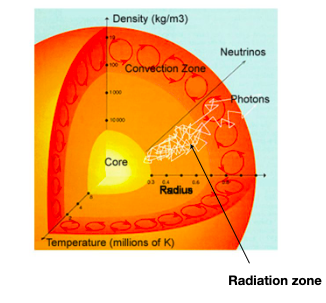
Why is the sun stable? (hydrostatic equilibrium)
Hydrostatic Equilibrium:
“hydro”: behaves like a fluid (which gases essentially do).
“static”: does not change.
“equilibrium”: a balance.
There are two main forces acting on the Sun:
Gravity: This force pulls all the Sun's mass inward toward its center. Gravity wants to collapse the Sun by pulling all of its gas and plasma toward the core.
Pressure from the hot gas: Inside the Sun, nuclear fusion in the core produces enormous heat, creating high pressure. This pressure pushes outward from the core to the surface, counteracting gravity.
Gravity tries to pull the Sun inward, while pressure from the hot gases pushes outward. These two forces are balanced, keeping the Sun stable in its current form.
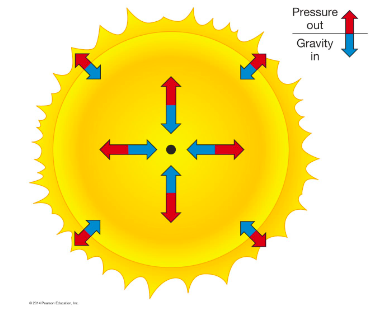
How does expected lifetime change with stars of different masses?
The lifetime of a star depends on its mass:
Massive stars (10+ times the Sun’s mass) burn fuel very quickly due to high core temperatures, so they live for only millions of years.
Medium stars (like the Sun) burn fuel at a moderate rate, giving them lifetimes of about 10 billion years.
Low-mass stars (red dwarfs) burn fuel slowly due to cooler cores, so they can live for trillions of years.
more massive stars live shorter lives because they burn through their fuel much faster than smaller stars.
What is the HR diagram, in general?
It is a graph in astronomy that plots the relationship between a star's luminosity (brightness) and its surface temperature, allowing astronomers to visualize and understand the different stages of a star's life cycle by showing where stars fall on the diagram based on their characteristics.
What are the axes on the HR diagram?
X-axis: Temperature (decreasing from left to right) or spectral type (O to M). Hotter stars are on the LEFT.
Y-axis: Luminosity (increasing upwards).
Both axes are a logarithmic scale
It shows how stars compare in temperature and brightness.
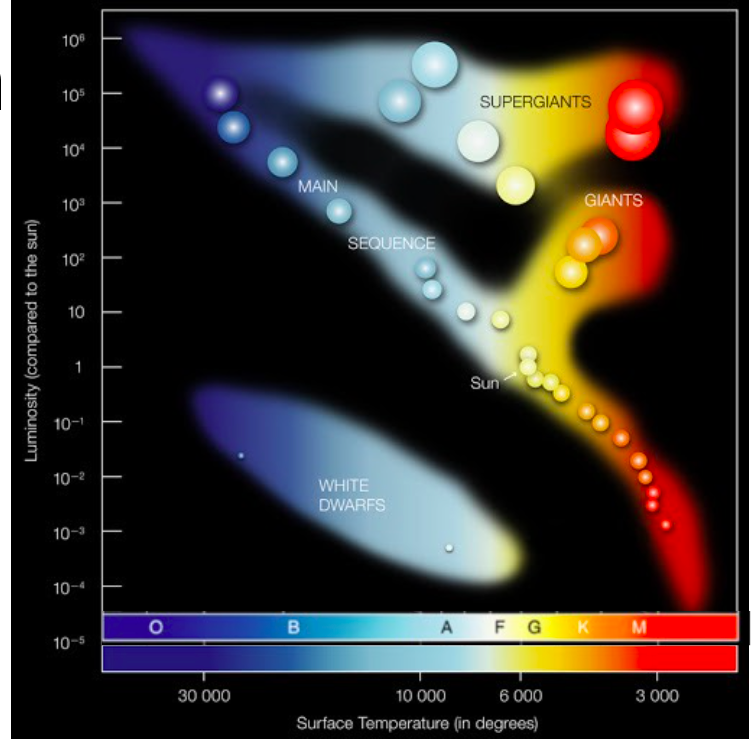
What is the main sequence on the HR diagram?
The main sequence stretching from the upper left (hot, luminous stars) to the bottom right (cool, faint stars) dominates the HR diagram, it’s where most stars are found. It is here that stars spend about 90% of their lives burning hydrogen into helium in their cores, they are in the stable phase of their life. Their “natural occurrence.”
Stars on the main sequence vary in temperature and luminosity, but all are generating energy through hydrogen fusion.
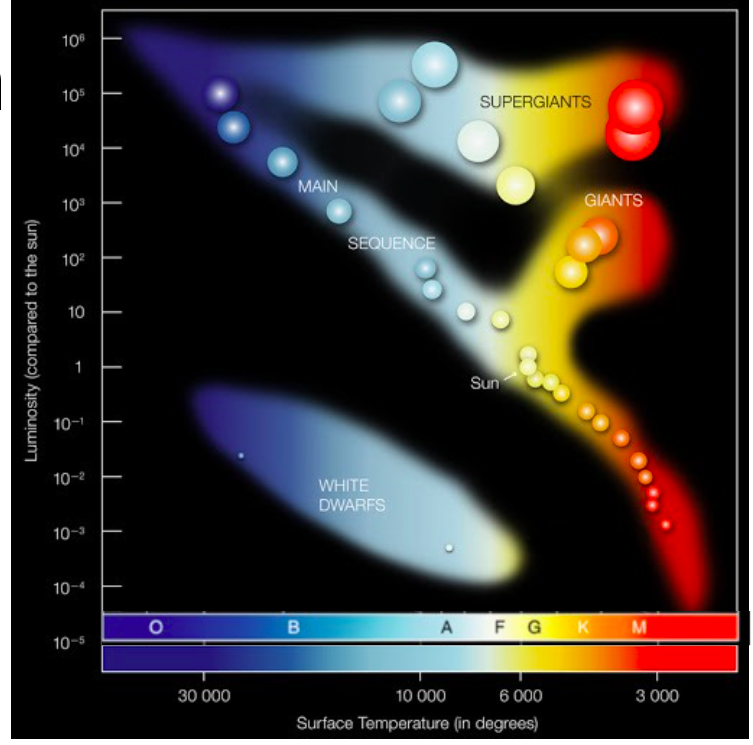
HR diagram: where are the giants? where are the white dwarfs? where are the pre-main-sequence stars
pre-main-sequence: young stars that have not yet begun the process of hydrogen fusion in its core. it is still contracting and generating energy through gravitational contraction.
giants/supergiants: cool but bright, luminous stars, located in the upper right. much larger than main sequence stars. have expanded because of alternative energy sources/new hydrostatic equilibrium. one of the last few phases of the stars life.
white dwarfs: dead stars with no fusion, located in the lower left. they give off light simply because they are hot. final stage of the stars life.
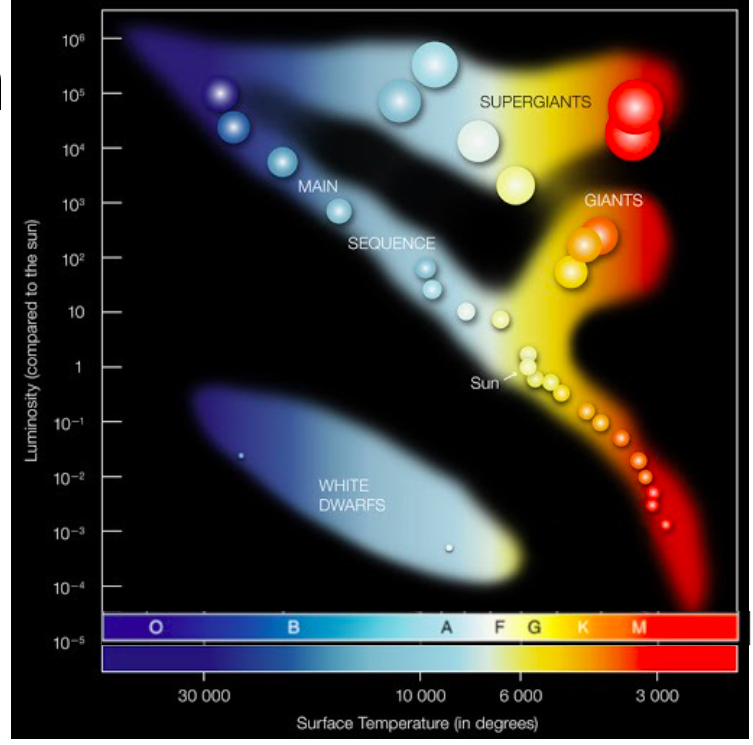
How long do stars spend at each phase on the HR diagram?
THIS ALL DEPENDS ON A STARS MASS! the higher the stars mass, the shorter the lifespan overall.
pre-main sequence: spend a few million years here. they are contracting heat in order to begin hydrogen fusion. low mass takes longer to reach main sequence!
main sequence: main part of a stars life, lasting for most of its lifespan. low mass stars can spend trillions of years here, while medium mass (sun-like) stars spend about 10 billion years, and high mass stars spend only millions of years here
giants/supergiants: this phase is relatively short. low to medium mass stars spend a few hundred million to a billion years here, while for massive stars it’s just a few million years.
white dwarfs: this phase only lasts a few tens of thousands of years. specifically for low-medium mass stars. it can cool slowly for over a billion years, but doesn’t undergo fusion anymore.
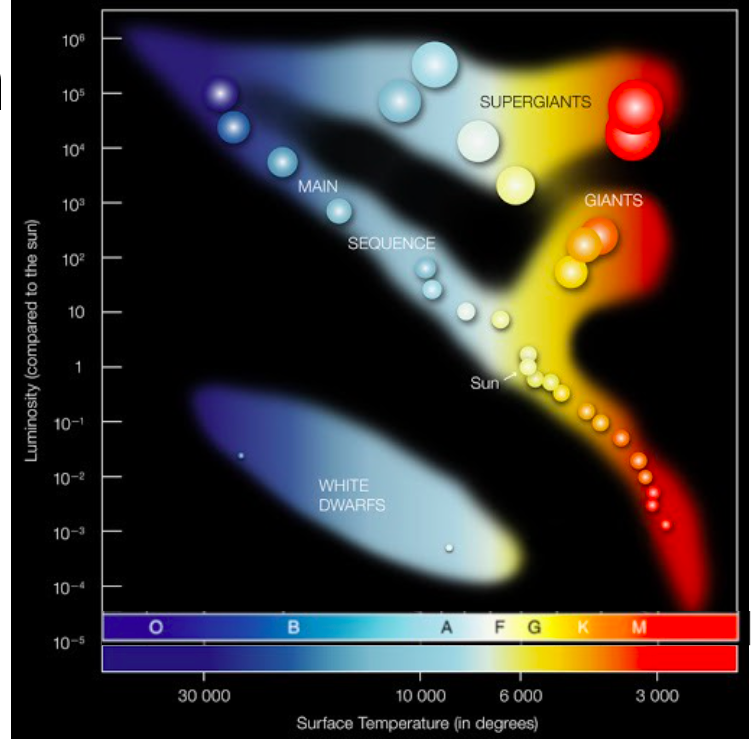
In both the pre-main sequence evolution and the post-main sequence evolution (the giant phase) what is happening if a star changes luminosity without changing temperature?
When a star changes luminosity without changing temperature during either pre-main sequence or giant phases, it is primarily due to a significant change in its radius, meaning the star is physically expanding or contracting, thus altering how much energy is emitted overall while maintaining its surface temperature relatively constant.
Stefan’s law! a star’s luminosity depends on both its temperature and surface area.
What is the general notion about how stars form?
Stars form in five different phases:
interstellar cloud: Denser than average cloud of gas. It’s dense because it’s small. By the perfect gas law, it has to
get colder than average. These clouds can be millions of solar masses.
cloud fragment: Within the cloud, the density is inhomogeneous: fluctuates throughout the cloud. These denser pockets are again cooler, releasing energy by radiation.
Eventually these clouds get dense enough that they fragment from the original cloud, held together by their self-gravity. process repeats in these fragments → small clumps.
protostar: fragmentation and cooling stops when the core of the cloud can no longer get rid of its heat. before, radiation transport was possible because the cloud was still “optically thin.” But once the core becomes “optically thick” the heat is trapped inside the cloud, and it will start to heat up.
not hot enough to fuse H, but can start emitting light. Cool, but much brighter than the sun because of its larger radius.
Have disks of gas and dust. Must clear this. Can coagulate to make balls of rock and ice: planets!star: object is now hot enough in the core to start fusing Hydrogen into Helium. It’s not on the main sequence yet — it has to settle into hydrostatic equilibrium with radius and temperature.
main sequence star: fully settled and in its equilibrium. when first arrived, it’s called “Zero-age main sequence” or ZAMS.
This whole process is less than 1% of the stars total lifetime.
Why is it that stars form in clusters?
they originate from large, dense clouds of gas and dust called molecular clouds, where multiple areas within the cloud can collapse under their own gravity to form stars simultaneously, essentially "clumping" together due to their close proximity and mutual gravitational pull.
Why do galaxies leave the main sequence? Why does their luminosity increase? Why do they stop creating energy from fusion? And then what happens to their temperature and luminosity?
galaxies leave the main sequence when they run out of the gas needed to form new stars.
when a galaxy leaves the main sequence, many of its stars evolve off the main sequence into giants or supergiants, which are more luminous than main-sequence stars. These stars contribute to the galaxy’s increased overall brightness as they expand and burn more fuel.
as stars in a galaxy age and exhaust the hydrogen in their cores, they stop fusing hydrogen. Without a fresh supply of gas to form new stars, the galaxy's ability to produce new energy from fusion declines.
Eventually, both temperature and luminosity decreases. fewer stars are form, so the main stars cool down as the evolve. luminosity has its initial increase, then gradually fades.
How do variable stars help us with the distance ladder?
They are key for measuring distances because their luminosities are known, using their known brightness as a reference. By measuring distances to these stars, we can calibrate distances to further galaxies, making them key tools in the cosmic distance ladder.
There is one and only one way to directly measure the distance to an astronomical object. Parallax.
But this method is very “local”. It only gets you to short distances.
Everything else depends on what we call “standard candles,” objects where we can determine their intrinsic luminosity

How do globular clusters tell us how old the universe is?
Globular clusters contain some of the oldest stars, and by studying their main sequence turn-off points, astronomers can estimate their ages. These ages help set a lower limit on the age of the universe, indicating it is at least 12 to 13 billion years old.
The more massive stars leave the main sequence first, so by identifying this point, astronomers can determine the cluster's age.
By comparing the observed properties of stars in globular clusters to theoretical models of stellar evolution, astronomers can estimate their ages.
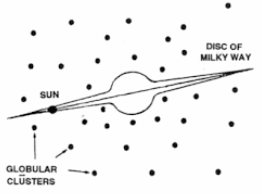
What is a globular cluster?
100,000’s to a million stars. Very tightly packed/dense together. Will stay bound together for their entire lifetimes. They are associated with all types of galaxies. Typically 12-13 billion years old, and made up of older stars. They provide insights into the early universe.
Probably formed in the early universe from the collapse of a giant cloud of gas.
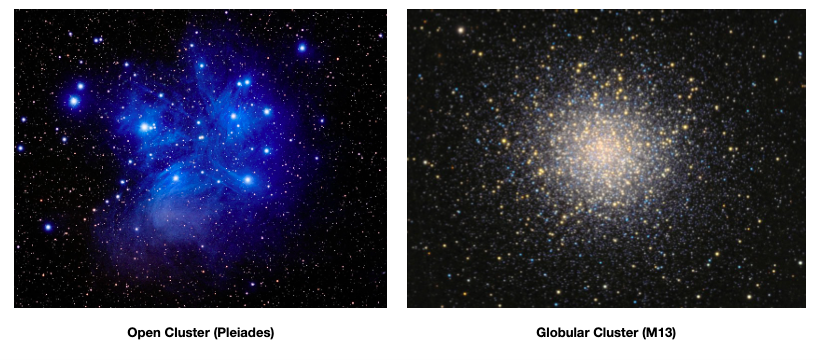
How does a globular cluster’s HR diagram change over time?
As time progresses, a globular cluster's HR diagram evolves from a main sequence-dominated distribution to one featuring more red giants and white dwarfs, reflecting the aging and evolution of its stars.
How do we age-date a globular cluster?
Using the HR diagram to determine the point at which stars in the cluster are leaving the main sequence:
Plot the stars' colors and luminosities
The HR diagram plots a star's color (temperature) versus its luminosity (brightness).
2Find the main sequence turnoff
As a cluster ages, the most massive stars run out of fuel first, which is called the main sequence turnoff.
Match the cluster's turnoff point to a theoretical isochrone
A theoretical isochrone is a line that goes through all the stars in a theoretical HR diagram for a population of stars with a specific age.
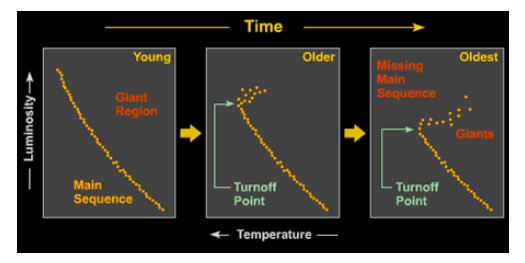
What happens with failed stars (brown dwarfs)?
When the cloud evaporates, there might be some protostars that were in their process of formation.
Or, another possibility is that two stars are forming right next to each other, and “compete” for gas.
These processes take away exterior gas from the protostar, leaving it as a big ball of gas not massive enough to burn Hydrogen.
